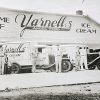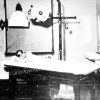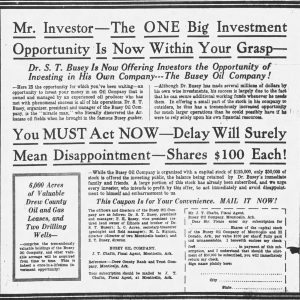calsfoundation@cals.org
Samuel Thompson Busey (1867–1962)
Samuel Thompson Busey was a 1920s oil speculator and promoter of the Arkansas oil industry. While originally trained as a physician, he later became a geologist and completed the famed “Discovery Well,” or Busey No. 1 Well, outside El Dorado (Union County) in 1921. Busey’s efforts helped usher in the south Arkansas oil boom of the 1920s.
Samuel Busey was born in Champaign County, Illinois, on February 10, 1867, and was the fifth of six children of John Simpson Busey and the former Caroline Marie Snyder. Busey came from a family of adventurers and community activists. His father was a farmer until 1845, when he left farming to travel across the United States. His father then took over his own father’s farm in 1856. John Busey would later win election as a Democrat to the Illinois House of Representatives in 1862 and would continue his interests in agricultural issues as he became involved in the Greenback Party in the 1870s and the sale of agricultural implements.
Busey’s namesake and father’s brother, Samuel Thompson Busey, rose to the rank of Brevet Brigadier General of Illinois volunteers during the Civil War and later served as a Democratic congressman from 1891 to 1893. Busey’s maternal grandfather, Dr. Jacob F. Snyder, left his medical practice in Indiana for California in 1849 to participate in the Gold Rush before heading to Urbana, Illinois, in 1850 to resume work as a physician.
Busey himself eventually became a medical doctor, though where he studied is not clear. A number of details of Busey’s life remain shrouded in uncertainty. He married Mary J. Jacobs in Kansas City, Missouri, on March 5, 1896. The marriage ended at an unknown date for unknown reasons. He later married Elsie M. Transue of Scotrun, Pennsylvania, a woman twenty years his junior, at an unspecified date.
Busey had a keen interest in both medicine and geology, but he was possessed by a desire to travel. Beginning in 1890, he would travel to Latin America, exploring Peru, Bolivia, Paraguay, Argentina, Chile, and Bolivia before eventually settling in Mexico and building a thriving medical practice in Mexico City.
In 1901, Busey traveled to Texas to examine the new Spindletop Well near Beaumont, the first successful oil well in Texas. Afterward, he and a group of investors attempted to drill oil wells near Vera Cruz, with mixed results. As the Mexican Revolution erupted in 1910, Busey closed his medical practice and once again resumed traveling. He eventually made his way to Bolivia, involving himself in a number of business activities. He organized the financing of the first successful rubber plantation in Bolivia and, in 1915, successfully completed an oil well in that country.
He returned to the United States, excited by his success in Bolivian oil. He lived for a time in New Jersey, Oklahoma, and Louisiana in the late 1910s, continuing to explore for oil.
In 1920, a well east of El Dorado was drilled and showed a large natural gas flow. Busey was in Homer, Louisiana, about forty miles away, and rode a horse to El Dorado to confirm the well information the next day. Unable to find a room, Busey bought the Arcade Hotel for $2,500.
By this time, the Mitchell-Bonham Drilling Company had acquired drilling rights on the eighty-acre David R. Armstrong farm southwest of El Dorado. It had drilled a well to a depth of about 1,700 feet, but operations were suspended for financial difficulties. On November 15, 1920, Busey arranged with local investors and took fifty-one percent ownership of the company, along with rights to the well, all tools, and the eighty-acre tract that was being drilled. Drilling operations were resumed, but by early January 1921, Busey had to sell off shares of the company and rights to some of the land to meet expenses. On January 10, 1921, at 4:30 p.m., the Busey No. 1 Well, as it was then named, was drilled to a depth of 2,233 feet and struck oil. Oil erupted to the surface, spraying the area with oil for more than a mile around. Busey’s rich Discovery Well produced an astounding fifteen million to thirty-five million cubic feet of natural gas and between 3,000 and 10,000 barrels of oil and water daily. This led to the oil boom that began petroleum development in Arkansas.
A frenzy struck El Dorado as thousands of speculators swarmed into the area seeking their fortunes, with Busey credited for it all. He quickly sold the hotel for $5,000 and was besieged by offers for the well. People sent money from all over the country to Busey for him to invest in the new south Arkansas oil industry. He declined the offers for the well and quietly returned all the money sent to him, and he began drilling in other areas of Union County.
Busey attempted to expand his oil operations into Drew County later in the 1920s. He had joined a group of oil speculators who believed that large quantities of oil were available in the Monticello (Drew County) area. Busey had boasted that Monticello would be “the next El Dorado,” but no oil reserves were discovered. Nevertheless, he took over and completed a well in Tallahatchie County, Mississippi, in 1924, which proved successful. Busey continued to operate oil leases in the El Dorado and Smackover (Union County) areas until 1928, when he sold his oil-producing properties in Arkansas.
He once explained that he was fascinated by challenges. “I was always a great hand to deal in junk. When others give up a well I like to take hold and see what I can do,” said Busey in a 1941 interview.
Busey continued to travel and involve himself in a variety of enterprises. By 1934, he was working on agricultural problems of insect and weed control, developing chemical sprays and equipment to use these products in farming. He spent the latter years of his life living in Michigan, Maryland, and Pennsylvania.
Busey died on November 24, 1962, in Elkton, Maryland. He is interred at Cumberland Cemetery in Media, Pennsylvania.
For additional information:
Buckalew, A. R., and R. B. Buckalew. “The Discovery of Oil in South Arkansas, 1920–1924.” Arkansas Historical Quarterly 32 (Autumn 1974): 195–208.
Ragsdale, John G. “Oil Development in South Arkansas, 1921–2001.” South Arkansas Historical Journal 3 (Fall 2003): 18–24.
Research Files, Arkansas Natural Resources Museum, Smackover, Arkansas.
Kenneth Bridges
South Arkansas Community College
John G. Ragsdale
Little Rock, Arkansas
 Business, Commerce, and Industry
Business, Commerce, and Industry Early Twentieth Century, 1901 through 1940
Early Twentieth Century, 1901 through 1940 Busey Oil Ad
Busey Oil Ad 




Comments
No comments on this entry yet.